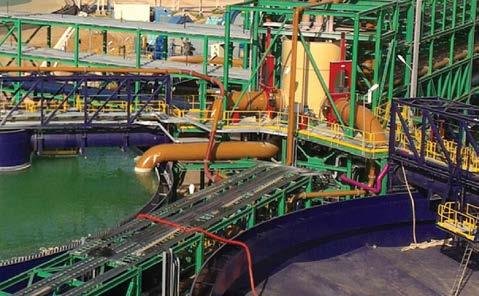
3 minute read
technical case study
benchmark. LCC uses the standard accounting principle of discounted cash flow. Costs of maintenance and associated downtime can outweigh the initial material costs. From a sustainability viewpoint it makes sense to calculate a full life cycle cost assessment.
LCC is the sum of acquisition cost, initial fabrication and installation costs, operational and maintenance costs, lost production due to down time, as well as replacement costs. However, at the end of the project life, all material involved and still available can be retrieved for re-use or recycling. The value of this can therefore be subtracted from the total cost.
When using stainless steel, the end of life value becomes very important. In architectural installations it is estimated that around 92% of the original material will be available for recycling. In the case of coated carbon steel or galvanised installations, this figure is closer to values between 62% and 68%. Therefore, our industry can proudly say that more than 75% of all new stainless steel material comes from recycled sources.
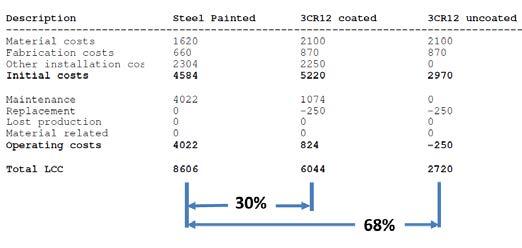
The Sassda application yields the results shown on the right with the highlights being that the uncoated 3CR12 version will be 68% lower in cost over the 15 years life span. Even if the 3CR12 is powder coated it would still be 30% less expensive than the coated carbon steel version.
Case Study 2: The Hydrometallurgical Walkway
At a hydrometallurgical plant in Chile material must be selected for a walkway across very corrosive areas in the plant. Service life is 30 years, and three possible material types are being suggested for use:
1. Mild steel - Cheapest option, but the material is to be coated. This would require maintenance and repairing the protective surface every four years.
2. 3CR12 - Unpainted. Every 15 years clean the surfaces with a high-pressure water.
3. Lean Duplex - Expensive material, but with exceptional mechanical and corrosion characteristics. Therefore, the material can be gauged down, meaning less kilograms will be required giving reduced initial material cost.
Once again, the results favour the use of 3CR12 with the utility grade showing a 50% reduction in life span costs compared to the mild steel option. Even the Duplex grade with very high initial costs display a reduction of 23% compared to the mild steel option. Take note of the impact of end of life value in the graphic depiction of the cost analysis.
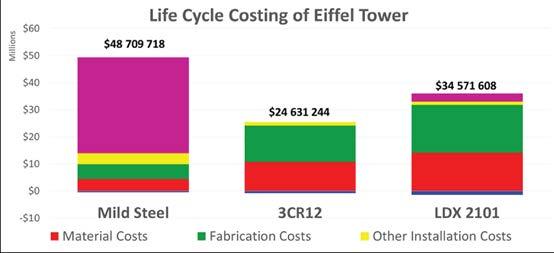
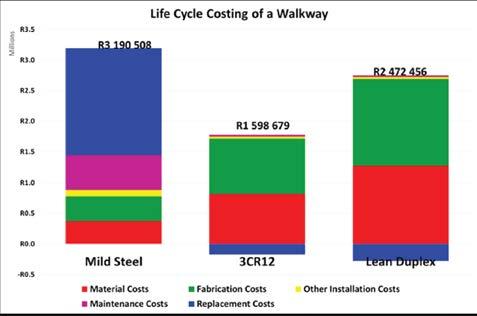
Case Study 3: The Repeat of the Eiffel Tower
Imagine you need to reconstruct the Eiffel Tower with a design life of 100 years. You have the following options: The potential grades would be a 3CR12, a duplex 2101, and mild steel like the material used on the existing tower. The mild steel will be painted with the current maintenance schedule. The 3CR12 will be allowed to form a surface patina. Therefore no maintenance will be required with 3CR12. The duplex material will always be maintained with a highpressure waterjet every 20 years rendering the new tower shiny. It comes as no surprise that the life cycle costs of the 3CR12 option is around 50% of the mild steel cost. The Lean Duplex version registers at around 77% of the mild steel cost.
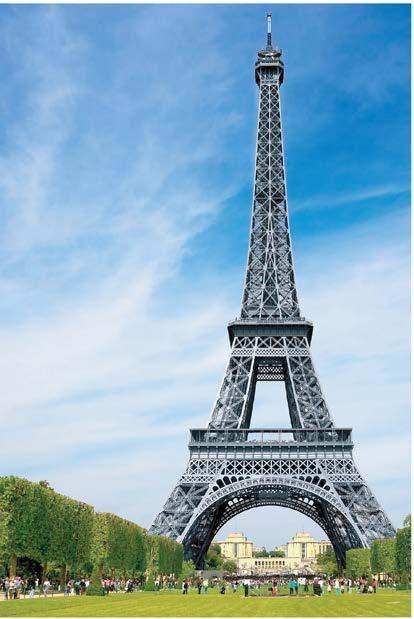
Case Study 4: Drinking Water solutions

The first three case studies showed the cost efficiency of stainless steel, especially 3CR12, against competitor materials. However, stainless steel can even compete against specific plastics used in drink water applications with a cost advantage over the life span. ISSF studies show an analysis of materials used in the pipework utilised in bringing water from the bulk supply to the end-user.
The life span used in this exercise is 100 years and based in the USD costs per 4m of installation pipework including fittings. The comparison was done between stainless steel, polyethylene, and PVC. The results speak for itself with stainless steel calculated to be at USD 2,172.00 per 4m length. The result for polyethylene stands at USD 3,340.00 and for PVC at USD 3,690.00 for the same length.
Stainless steel remains Simply Brilliant
In virtually all applications stainless steel shows substantial LCC ife benefits.

A - Acquisition Costs: Stainless steel contains more than 70% of recycled material.
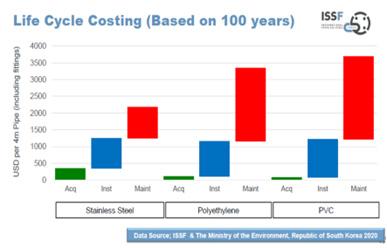
B - Fabrication and Installation: Stainless steel offers ease of fabrication and the mechanical properties allow for lighter structures.

C - Operational Costs: remains lower due to the durability of the material.
D - Lost production Costs: The durability of stainless steel also causes less down time and thus a reduction of related costs.
E - Maintenance Costs: Durability and less downtime leads to lower maintenance costs over and above the fact that stainless steel implies lower maintenance.
F – Recycling: The material complies with the standards for sustainability. Due to the high end of life material recovery rate, there is implied savings. Stainless steel is 100% recyclable.










